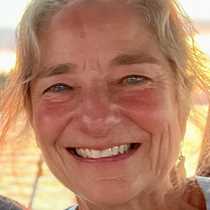Steeple Jason & Saunders Islands, Falkland Islands
We had the rare opportunity this morning to visit Steeple Jason, a remote and dramatic island topped by a sharp ridge of peaks. Its remote location, combined with strong currents, winds and waves often make landings impossible here.
Zodiacs brought us in to a tiny, protected, kelp-strewn beach. Immediately we saw many new birds, and many of us were captivated by the antics of the bold and curious bird called ‘Johnny Rook’ (striated caracara). The landscape was otherworldly. Tussac grass was taller than us, and scattered rocks were painted brilliant gold by lichens, with tassels of shaggy, long green lichen ‘hair.’ We continued onward past gentoo penguins to the albatross colony on the windward side of the island.
On the NW slope, fully exposed to the strong wind, is a dense colony, nearly 3 miles long, of more than 100,000 black-browed albatross. Many of us got closer by threading our way between clumps of tussac grass so dense and tall we could hardly see where we were going. Beautiful albatross sat patiently on pedestal nests, while countless others flew overhead. Sometimes they were so low, it seemed we could reach out and touch them. It was magical to be so close to such an abundance of birds.
I pondered their lives at sea, gliding effortlessly over huge ocean waves, riding winds for hundreds or thousands of miles in search of food at the sea surface. A few rockhopper penguins nested between albatross mounds. I found it wondrous that such drastically different birds shared nesting sites. The albatross is the epitome of elegance, grace and flying efficiency, sharing a crowded colony with rockhopper penguins. Underwater, the rockhoppers are hydrodynamic and swim quickly with paddle-like wings, but on land they look like cartoon characters with windblown yellow eyebrow feathers. We stood in head-high tussac grass over our heads and watched the abundance of the vast colony.
We had a blustery afternoon transit to Saunders Island. We stepped ashore on an enormous, wide, sandy beach. The fierce wind made gorgeous patterns in the sand, and at ankle level, rivers of sand traveled through the air. We had pelting rain, and a rainbow.
Gentoo penguins walked towards their colonies in sand dunes just above the beach. Magellanic penguins stood in tight groups in shallow water, far from their burrows dug in the hillside. A handful of king penguins stood at the back of the beach. Most of us trekked to the end of the beach to watch rockhoppers. What a sight they were: red eyes, red bill, wind-tossed yellow brow feathers. They leaned far forward into the gale-force wind, hopping and walking to or from the rock ledges. Cormorants attempted to fly, but could only move sideways in the breeze.
The chilly, sandy, windy, rainy conditions made the patches of blue sky and dramatic lighting even more precious. It all made for an unforgettable penguin-watching experience.




